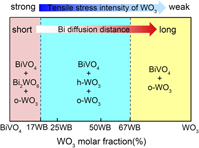Crossref Citations
This article has been cited by the following publications. This list is generated based on data provided by
Crossref.
Song, Haili
Li, Chao
Van, Chien Nguyen
Dong, Wenxia
Qi, Ruijuan
Zhang, Yuanyuan
Huang, Rong
Chu, Ying-Hao
and
Duan, Chun-Gang
2017.
Role of indium tin oxide electrode on the microstructure of self-assembled WO3-BiVO4 hetero nanostructures.
Journal of Applied Physics,
Vol. 122,
Issue. 17,
Song, Haili
Li, Chao
Nguyen Van, Chien
Dong, Wenxia
Qi, Ruijuan
Zhang, Yuanyuan
Huang, Rong
Chu, Ying-Hao
and
Duan, Chun-Gang
2018.
Microstructure evolution determined by the crystalline phases competition in self-assembled WO3-BiVO4 hetero nanostructures.
Journal of Applied Physics,
Vol. 123,
Issue. 8,
Li, Guoqiang
Kou, Shiwen
Zhang, Feng
Zhang, Weifeng
and
Guo, Haizhong
2018.
Target stoichiometry and growth temperature impact on properties of BiVO4 (010) epitaxial thin films.
CrystEngComm,
Vol. 20,
Issue. 43,
p.
6950.
Wang, Jie
Ren, LiZhen
Zhang, DongEn
Hao, XiaoYun
Gong, JunYan
Xiao, Xin
Jiang, YouXiang
and
Tong, ZhiWei
2018.
Fabrication of Bi2MoO6/BiOI heterojunction photocatalysts for enhanced photodegradation of RhB.
Journal of Materials Research,
Vol. 33,
Issue. 23,
p.
3928.
Tahir, M.B.
Iqbal, Tahir
Kiran, Habiba
and
Hasan, Ali
2019.
Insighting role of reduced graphene oxide in BiVO4
nanoparticles for improved photocatalytic hydrogen evolution and dyes degradation.
International Journal of Energy Research,
Vol. 43,
Issue. 6,
p.
2410.
Lee, Seungchul
Song, Jaesun
Jo, Yong-Ryun
Choi, Kyoung Soon
Lee, Jongmin
Seo, Sehun
Kim, Taemin Ludvic
Jang, Ho Won
Jeon, Cheolho
Kim, Bong-Joong
Kim, Bongjae
and
Lee, Sanghan
2019.
In Situ Growth of Nanostructured BiVO4–Bi2O3 Mixed-Phase via Nonequilibrium Deposition Involving Metal Exsolution for Enhanced Photoelectrochemical Water Splitting.
ACS Applied Materials & Interfaces,
Vol. 11,
Issue. 47,
p.
44069.
Li, Guoqiang
Shen, Qianyun
Yang, Zhenzhong
Kou, Shiwen
Zhang, Feng
Zhang, Weifeng
Guo, Haizhong
and
Du, Yingge
2019.
Photocatalytic behaviors of epitaxial BiVO4 (010) thin films.
Applied Catalysis B: Environmental,
Vol. 248,
Issue. ,
p.
115.
Wang, Lele
Chen, Shanshan
Wu, Pengcheng
Wu, Keliang
Wu, Jianning
Meng, Guihua
Hou, Juan
Liu, Zhiyong
and
Guo, Xuhong
2020.
Enhanced optical absorption and pollutant adsorption for photocatalytic performance of three-dimensional porous cellulose aerogel with BiVO4 and PANI.
Journal of Materials Research,
Vol. 35,
Issue. 10,
p.
1316.
Lippmaa, Mikk
Kawasaki, Seiji
Takahashi, Ryota
and
Yamamoto, Takahisa
2021.
Nanopillar composite electrodes for solar-driven water splitting.
MRS Bulletin,
Vol. 46,
Issue. 2,
p.
142.
Kou, Shiwen
Yu, Qiaonan
Peng, Yaru
and
Li, Guoqiang
2021.
Benefits on photocarrier transfer from the transition of 3D to a 2D morphology.
CrystEngComm,
Vol. 23,
Issue. 27,
p.
4825.
Thirupugazhmani, V.
Thirumalai, K.
Shameena, S.
and
Ravi, A.
2021.
WITHDRAWN: Novel synthesis and enhanced photocatalytic effect of RGO supported Ho2WO6-ZnO.
Materials Today: Proceedings,
Gu, Shuo
Zhang, Yi
Zhou, Xiaoyu
Sun, Kai
Wu, Di
Gao, Kaiyue
and
Wang, Xiufang
2021.
Bi–MO bimetallic Co-catalyst modified Bi2MoO6 for enhancing photocatalytic performance.
Journal of Materials Research,
Vol. 36,
Issue. 3,
p.
646.
